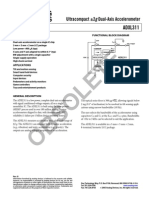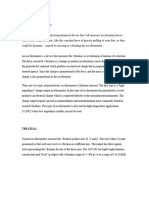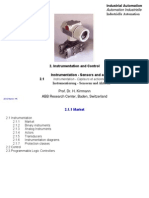Features: 253 L FS 0055 ST
Features: 253 L FS 0055 ST
Uploaded by
CAFECHINOCopyright:
Available Formats
Features: 253 L FS 0055 ST
Features: 253 L FS 0055 ST
Uploaded by
CAFECHINOOriginal Title
Copyright
Available Formats
Share this document
Did you find this document useful?
Is this content inappropriate?
Copyright:
Available Formats
Features: 253 L FS 0055 ST
Features: 253 L FS 0055 ST
Uploaded by
CAFECHINOCopyright:
Available Formats
Special Edition Length
Features
- Angle Displacement Measurement - Bends and Flexes physically with motion device - Possible Uses - Robotics - Gaming (Virtual Motion) - Medical Devices - Computer Peripherals - Musical Instruments - Physical Therapy - Simple Construction - Low Profile
Mechanical Specifications
-Life Cycle: >1 million -Height: 0.43mm (0.017") -Temperature Range: -35C to +80C
Electrical Specifications
-Flat Resistance: 25K Ohms -Resistance Tolerance: 30% -Bend Resistance Range: 45K to 125K Ohms (depending on bend radius) -Power Rating : 0.50 Watts continuous. 1 Watt Peak
Dimensional Diagram - Stock Flex Sensor
PART LENGTH 73.66 [2.900] ACTIVE LENGTH 55.37 [2.180]
6.35 [0.250]
How to Order - Stock Flex Sensor
FS Series
FS = Flex Sensor
L Model
L = Linear
0055 Active Length
0055 = 55.37mm
253 Resistance
253 = 25K Ohms
ST Connectors
ST = Solder Tab
How It Works
Flat (nominal resistance) 45 Bend (increased resistance) 90 Bend (resistance increased further)
spectrasymbol.com
Rev A2 - Page 1
(888) 795-2283
Schematics
Following are notes from the ITP Flex Sensor Workshop "The impedance buffer in the [Basic Flex Sensor Circuit] (above) is a single sided operational amplifier, used with these sensors because the low bias current of the op amp reduces errer due to source impedance of the flex sensor as voltage divider. Suggested op amps are the LM358 or LM324." "You can also test your flex sensor using the simplest circut, and skip the op amp." "Adjustable Buffer - a potentiometer can be added to the circuit to adjust the sensitivity range."
"Variable Deflection Threshold Switch - an op amp is used and outputs either high or low depending on the voltage of the inverting input. In this way you can use the flex sensor as a switch without going through a microcontroller."
"Resistance to Voltage Converter - use the sensor as the input of a resistance to voltage converter using a dual sided supply op-amp. A negative reference voltage will give a positive output. Should be used in situations when you want output at a low degree of bending."
spectrasymbol.com
Page 2
(888) 795-2283
You might also like
- Light Sensitive AlarmDocument15 pagesLight Sensitive AlarmJamal Banzi50% (2)
- Mkm1133 Instrumentation and Control SystemDocument19 pagesMkm1133 Instrumentation and Control SystemNurul Nadia Mohd ZawawiNo ratings yet
- Features: 103 L FS 0112 STDocument2 pagesFeatures: 103 L FS 0112 STPhạm Quốc AnhNo ratings yet
- Flex Sensor Data Sheet 2014 PDFDocument2 pagesFlex Sensor Data Sheet 2014 PDFAndre Escobedo AriasNo ratings yet
- Flexsensor PDFDocument2 pagesFlexsensor PDFVictor ManuelNo ratings yet
- Precision Power Analyzer: 1 To 8 Channels DC - 10 MHZ Accuracy 0.025 %Document12 pagesPrecision Power Analyzer: 1 To 8 Channels DC - 10 MHZ Accuracy 0.025 %tsampouriseNo ratings yet
- Flex Sensor 4.4 InchDocument2 pagesFlex Sensor 4.4 Inchfaisal aminNo ratings yet
- 555 TimerDocument3 pages555 TimerPraveen KumarNo ratings yet
- Unit 8: Unit 8: Unit 8: Unit 8:: Sensors & Actuators Sensors & Actuators Sensors & Actuators Sensors & ActuatorsDocument33 pagesUnit 8: Unit 8: Unit 8: Unit 8:: Sensors & Actuators Sensors & Actuators Sensors & Actuators Sensors & ActuatorsshreedharkolekarNo ratings yet
- Lmx31X Precision Voltage-To-Frequency Converters: 1 Features 3 DescriptionDocument23 pagesLmx31X Precision Voltage-To-Frequency Converters: 1 Features 3 DescriptionAlonso Herrera SeguraNo ratings yet
- Aiwa Z Ht730Document46 pagesAiwa Z Ht730Kaspars KruminsNo ratings yet
- Analog Sensors AssignmentDocument7 pagesAnalog Sensors AssignmentPathum SudasingheNo ratings yet
- ADXL311 SensorDocument12 pagesADXL311 Sensorhacguest8485No ratings yet
- Questions and AnswersDocument15 pagesQuestions and AnswersMahtab GhummanNo ratings yet
- Ultrasonic Cutter Mechanism (Regarding Oscillator) Constant Amplitude ControlDocument9 pagesUltrasonic Cutter Mechanism (Regarding Oscillator) Constant Amplitude ControlVijay SakhareNo ratings yet
- A3150Document12 pagesA3150Pham LongNo ratings yet
- Upower Analog 2Q08 Calpoly SM FinalDocument36 pagesUpower Analog 2Q08 Calpoly SM FinalSteveAbonyiNo ratings yet
- Accelerometer:-: Musical InstrumentDocument14 pagesAccelerometer:-: Musical InstrumentJyotirekha PatiNo ratings yet
- Overview of SsrsDocument3 pagesOverview of SsrsDavid MartinNo ratings yet
- CMicrotek 50 Nano Ampere Current Probe - UCP1x0 - Probe - FlierDocument2 pagesCMicrotek 50 Nano Ampere Current Probe - UCP1x0 - Probe - FliernicefireworkNo ratings yet
- Aiwa Nsx-sz900 Cx-nsz900 SMDocument47 pagesAiwa Nsx-sz900 Cx-nsz900 SMc19606100% (1)
- Basic InstrumentationDocument55 pagesBasic InstrumentationvenkatsubbuNo ratings yet
- Main AfsDocument14 pagesMain AfsIbrahim KaithakkodanNo ratings yet
- Unit VDocument56 pagesUnit Vvlsimicroelectronics.sseNo ratings yet
- ACCELEROMETERDocument9 pagesACCELEROMETERDHAMO DHARANNo ratings yet
- IS5026 Operating InstructionDocument3 pagesIS5026 Operating InstructionMarchelius KalvinNo ratings yet
- Implementation of Square Wave, Sine Wave, and Triangular Wave Generator Using Operational Amplifier CircuitDocument36 pagesImplementation of Square Wave, Sine Wave, and Triangular Wave Generator Using Operational Amplifier CircuitCharles BurgosNo ratings yet
- Adxl 335Document16 pagesAdxl 335Castro FedericoNo ratings yet
- Aiwa CX-ZL500 Manual de ServicioDocument37 pagesAiwa CX-ZL500 Manual de Serviciovanerito100% (1)
- Devicecraft: Hall Effect Isolated Current SensorDocument6 pagesDevicecraft: Hall Effect Isolated Current SensorrogerroseNo ratings yet
- Flex SensorsDocument4 pagesFlex SensorsLavanya Vaishnavi D.A.No ratings yet
- Op - Amp.741 and 555 ICDocument6 pagesOp - Amp.741 and 555 ICManojkumarNo ratings yet
- HWSC S A0012939215 1-3073398Document7 pagesHWSC S A0012939215 1-3073398carlosibaNo ratings yet
- Full Report - E1Document13 pagesFull Report - E1Naddy MohdNo ratings yet
- Gate Triggering CircuitDocument82 pagesGate Triggering Circuitvraj loginpurposeNo ratings yet
- CX Z1900LHDocument43 pagesCX Z1900LHDavid Argote BellidoNo ratings yet
- AI 210 InstrumentationDocument61 pagesAI 210 InstrumentationSiswoyo SuwidjiNo ratings yet
- TransducerDocument70 pagesTransducersmcoolguy68100% (1)
- AI 210 InstrumentationDocument61 pagesAI 210 InstrumentationBurhan KhanNo ratings yet
- Minor Project Report: Submitted byDocument20 pagesMinor Project Report: Submitted byDurgesh ShuklaNo ratings yet
- DCpower SuplyDocument12 pagesDCpower Suplymm30973097No ratings yet
- Displacement Sensors: 1. Resistance Based and Optical Incremental Sensors of Position TaskDocument7 pagesDisplacement Sensors: 1. Resistance Based and Optical Incremental Sensors of Position TaskBoobalan ThirugnanasambandamNo ratings yet
- T2 - Proximity Transducer System OperationDocument34 pagesT2 - Proximity Transducer System Operationarijitnag100% (1)
- Combined Overcurrent & Earth-Fault Relay: Type SPAJ 140 CDocument8 pagesCombined Overcurrent & Earth-Fault Relay: Type SPAJ 140 CturboedNo ratings yet
- 9441 Panasonic SA-AK270PL GCP Sistema Audio CD Multidisco MP3-Casette Manual de ServicioDocument121 pages9441 Panasonic SA-AK270PL GCP Sistema Audio CD Multidisco MP3-Casette Manual de Serviciowilmerk_159990No ratings yet
- Project SensorsDocument8 pagesProject SensorsKarthikeyaNo ratings yet
- Panasonic SA-AK960 Mini ComboDocument121 pagesPanasonic SA-AK960 Mini Comboppstone100% (3)
- Panasonic-SAAK860GCP Audio SysDocument118 pagesPanasonic-SAAK860GCP Audio SysMarcos DAquinoNo ratings yet
- Aiwa+Cx Nsz50lh SMDocument40 pagesAiwa+Cx Nsz50lh SMSandro Aniello LunascoNo ratings yet
- @1b - Semiconductors Diodes and ApplicationsDocument269 pages@1b - Semiconductors Diodes and Applicationsminh vũNo ratings yet
- Siemens s566b ElectroniDocument3 pagesSiemens s566b ElectronialexNo ratings yet
- Open Collector OutputDocument4 pagesOpen Collector OutputApurbaNo ratings yet
- Device Craft Current Sensor Is 5 And6and7Document5 pagesDevice Craft Current Sensor Is 5 And6and7rogerroseNo ratings yet
- Reference Guide To Useful Electronic Circuits And Circuit Design Techniques - Part 2From EverandReference Guide To Useful Electronic Circuits And Circuit Design Techniques - Part 2No ratings yet
- Reference Guide To Useful Electronic Circuits And Circuit Design Techniques - Part 1From EverandReference Guide To Useful Electronic Circuits And Circuit Design Techniques - Part 1Rating: 2.5 out of 5 stars2.5/5 (3)
- STEM: Science, Technology, Engineering and Maths Principles Teachers Pack V10From EverandSTEM: Science, Technology, Engineering and Maths Principles Teachers Pack V10No ratings yet
- Analog Dialogue, Volume 48, Number 1: Analog Dialogue, #13From EverandAnalog Dialogue, Volume 48, Number 1: Analog Dialogue, #13Rating: 4 out of 5 stars4/5 (1)
- Pid Loop ShapingDocument7 pagesPid Loop ShapingCAFECHINONo ratings yet
- Filtec Case Inspection BrochureDocument2 pagesFiltec Case Inspection BrochureCAFECHINONo ratings yet
- Basic DC Motor Speed PID Control With The Infineon C167 FamilyDocument10 pagesBasic DC Motor Speed PID Control With The Infineon C167 FamilyCAFECHINONo ratings yet
- TA7291PDocument15 pagesTA7291PCAFECHINONo ratings yet































































